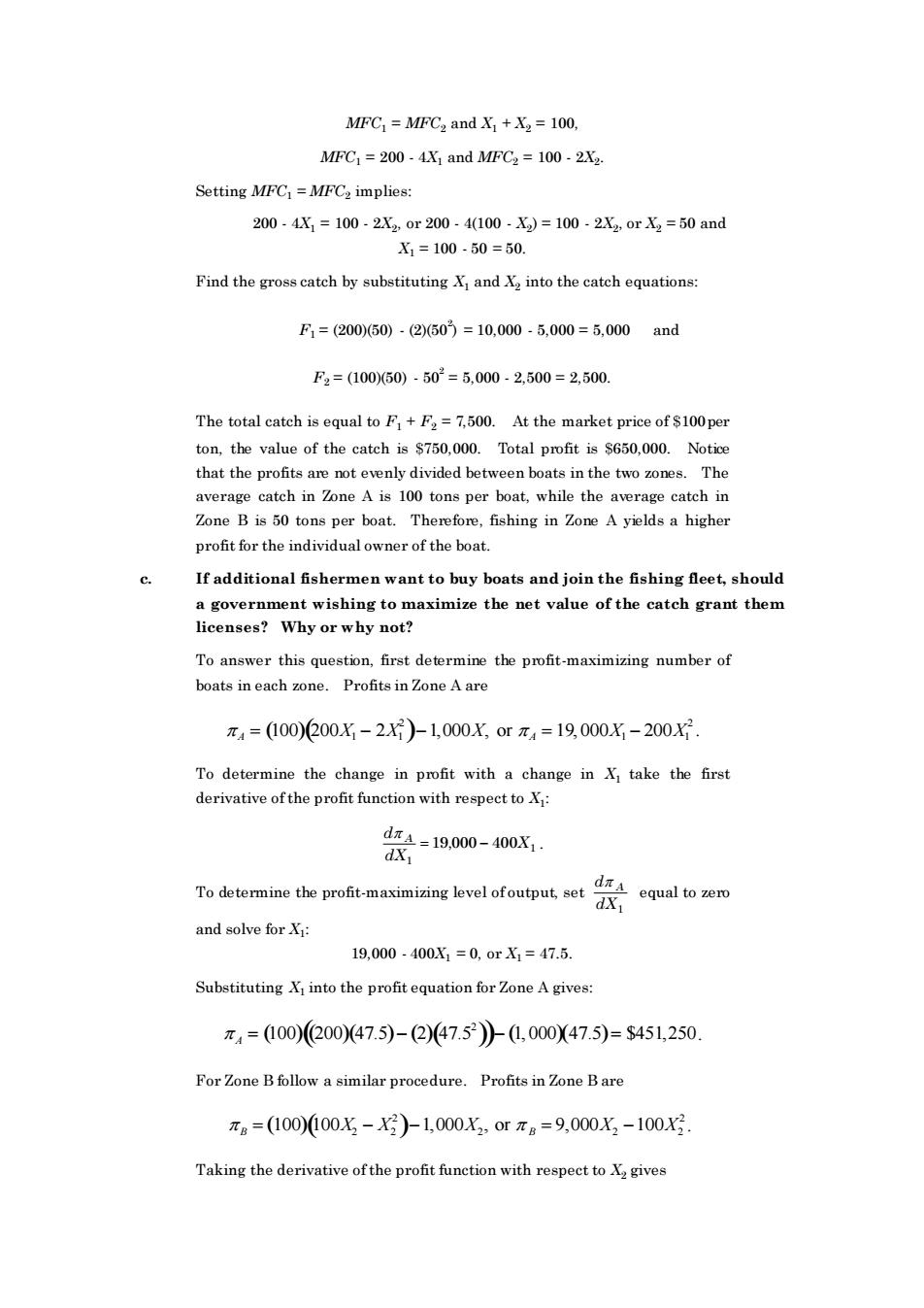正在加载图片...

MFC]MFCz and X +X2 100. MFC 200-4X1 and MFC2 100-2X2 Setting MFC=MFC2 implies: 200.4X1=100.2X20r200-4(100-X)=100.2X0rX2=50and X1=100.50=50. Find the gross catch by substituting X and Ninto the catch equations F=(20050)·(2605=10,.000.5.000=5,000and F2=(100)50)·502=5,000.2,500=2,500. The total catch is equal toF+F=7.500.At the market price of $100per value of the catch.Total.Noti that the profits are not evenly divided betw reen boats in the two zones average catch in Zone A is 100 tons per boat,while the average catch in Zone B is 50 tons per boat.Therefore,fishing in Zone A yields a higher profit for the individual owner of the boat. If additional fishermen want to buy boats and join the fishing fleet,should ent wishing to maximize the net value of the catch grant them To answer this question,first determine the profit-maximizing number of boats in each zone.Profits in Zone A are π4=(100)200X-2X)1,000X,or元4=19000X-200X. To determine the change in profit with a change in X take the first derivative ofthe profit function with respect to X: a=19000-400x,. and solve for X1: 19,000.400X=0,orX1=47.5. Substituting X into the profit equation for Zone A gives: π4=100)20047.5)-(2)47.532)】0,000X47.5)=$451,250. ForZone Bfollow a similar procedure.Profits inZone Bare 元a=(100)000-X)1,000X,orπB=9,000X-100X经 Taking the derivative ofthe profit function with respectMFC1 = MFC2 and X1 + X2 = 100, MFC1 = 200 - 4X1 and MFC2 = 100 - 2X2 . Setting MFC1 = MFC2 implies: 200 - 4X1 = 100 - 2X2 , or 200 - 4(100 - X2 ) = 100 - 2X2 , or X2 = 50 and X1 = 100 - 50 = 50. Find the gross catch by substituting X1 and X2 into the catch equations: F1 = (200)(50) - (2)(502 ) = 10,000 - 5,000 = 5,000 and F2 = (100)(50) - 502 = 5,000 - 2,500 = 2,500. The total catch is equal to F1 + F2 = 7,500. At the market price of $100 per ton, the value of the catch is $750,000. Total profit is $650,000. Notice that the profits are not evenly divided between boats in the two zones. The average catch in Zone A is 100 tons per boat, while the average catch in Zone B is 50 tons per boat. Therefore, fishing in Zone A yields a higher profit for the individual owner of the boat. c. If additional fishermen want to buy boats and join the fishing fleet, should a government wishing to maximize the net value of the catch grant them licenses? Why or why not? To answer this question, first determine the profit-maximizing number of boats in each zone. Profits in Zone A are A = (100) 200X1 − 2X1 2 ( )−1,000X, or A = 19, 000X1 − 200X1 2 . To determine the change in profit with a change in X1 take the first derivative of the profit function with respect to X1 : d dX X A 1 = 19 000 − 400 1 , . To determine the profit-maximizing level of output, set d dX A 1 equal to zero and solve for X1 : 19,000 - 400X1 = 0, or X1 = 47.5. Substituting X1 into the profit equation for Zone A gives: A = (100) (200)(47.5)− (2) 47.5 2 ( ( ))− (1, 000)(47.5)= $451,250. For Zone B follow a similar procedure. Profits in Zone B are B = (100) 100X2 − X2 2 ( )−1,000X2 , or B = 9,000X2 −100X2 2 . Taking the derivative of the profit function with respect to X2 gives